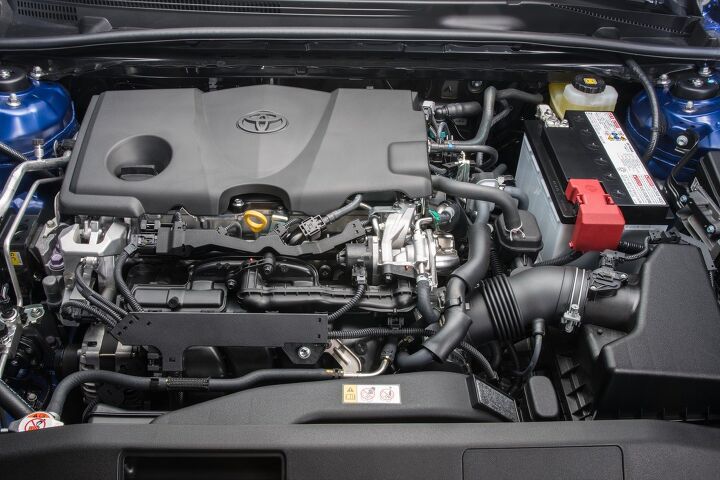Don't Go All Hybrid/Turbo/Electric/Fuel Cell Just Yet - Toyota V6 And V8 to Gain "Dynamic Force" Camry Engine Tech
Forget hybrids. Set aside, for this moment, plug-in hybrids as well. Ignore the EV hubbub and the pie-in-the-sky hydrogen fuel cells. While you’re at it, remove turbochargers and their accompanying displacement reductions from your memory, too.
The naturally aspirated internal combustion engine has legs. The proof is in the 2018 Toyota Camry’s 2.5-liter Dynamic Force four-cylinder. With no hybrid assist, no turbos, no cord that plugs into your garage wall, and no futuristic fuel source, the new Camry 2.5-liter produces 206 horsepower and hits 41 miles per gallon on the highway on regular 87 octane.
That’s 16-percent more power 24-percent more highway mpg than the 2017 Camry’s 2.5-liter four-cylinder. With improvements in conventional, naturally aspirated, gas-fired engines occurring in such leaps and bounds, it’s no wonder Toyota has bigger plans for the Dynamic Force blueprint.
According to Ben Schlimme, Toyota’s executive program manager for powertrains, says “Dynamic Force is not solely aimed at the 2.5-liter engine.” According to Automotive News, Schlimme says the tech featured in the Camry’s 2.5 is destined for other segments, and V6 and V8 editions are now in concept form.
Getting the 2.5 to make substantially more power, without turbocharging and without harming efficiency, involved focusing on good ol’ fashioned fundamentals: friction, air flow, and cooling. Fundamental ideals for engineers, they may be, but enhancing the powerplant required new approaches: “high-speed combustion technology and a variable control system,” Toyota says, with a widened angle between intake and exhaust valves, a laser-cladded valve seat, and “strengthened tumble flow and high performance injector” which improve the fuel/air mixture, among other changes.
Much of the work Toyota did to the 2.5-liter is based on the need to improve the efficiency of its hybrids. “Our electrification pathway relies on these improvements of our internal-combustion engine,” Schlimme says, “hence we put a lot of effort ensuring that this base engine delivers on those principles.”
It doesn’t sound like Toyota is preparing us for a 2025 in which there will be few dealers, a near-100-percent electric fleet, and extensive ride-sharing in autonomous Ubers. You’ll recall Mazda’s belief: internal combustion engines are in the works until at least 2050.
Whether Toyota takes conventional engines that far won’t soon be determined. But if the next iteration of the 2.5-liter Toyota four-cylinder makes similar advances, and if Toyota applies similar improvements to V6 and V8 engines, we won’t be disappointed by missing battery packs and absent turbochargers.
[Images: Toyota]
Timothy Cain is a contributing analyst at The Truth About Cars and Autofocus.ca and the founder and former editor of GoodCarBadCar.net. Follow on Twitter @timcaincars.
More by Timothy Cain
Latest Car Reviews
Read moreLatest Product Reviews
Read moreRecent Comments
- Teddyc73 Oh good lord here we go again criticizing Cadillac for alphanumeric names. It's the same old tired ridiculous argument, and it makes absolutely no sense. Explain to me why alphanumeric names are fine for every other luxury brand....except Cadillac. What young well-off buyer is walking around thinking "Wow, Cadillac is a luxury brand but I thought they had interesting names?" No one. Cadillac's designations don't make sense? And other brands do? Come on.
- Flashindapan Emergency mid year refresh of all Cadillac models by graphing on plastic fenders and making them larger than anything from Stellantis or Ford.
- Bd2 Eh, the Dollar has held up well against most other currencies and the IRA is actually investing in critical industries, unlike the $6 Trillion in pandemic relief/stimulus which was just a cash giveaway (also rife with fraud).What Matt doesn't mention is that the price of fuel (particularly diesel) is higher relative to the price of oil due to US oil producers exporting records amount of oil and refiners exporting records amount of fuel. US refiners switched more and more production to diesel fuel, which lowers the supply of gas here (inflating prices). But shouldn't that mean low prices for diesel?Nope, as refiners are just exporting the diesel overseas, including to Mexico.
- Jor65756038 As owner of an Opel Ampera/Chevrolet Volt and a 1979 Chevy Malibu, I will certainly not buy trash like the Bolt or any SUV or crossover. If GM doesn´t offer a sedan, then I will buy german, sweedish, italian, asian, Tesla or whoever offers me a sedan. Not everybody like SUV´s or crossovers or is willing to buy one no matter what.
- Bd2 While Hyundai has enough models that offer a hybrid variant, problem has been inadequate supply, so this should help address that.In particular, US production of PHEVs will make them eligible for the tax credit.




































Comments
Join the conversation
While I wouldn't want to deprive the TTAC keyboard warriors the delight they attain in demeaning each other, I wonder if anyone has done an actual study comparing similar turbocharged and non-turbocharged engines? I'm old enough to remember when engines needed to be rebuilt at the 80-100,000 mile mark, and automakers struggled to achieve 20mpg in economy cars, with engines that produced double digit horsepower. However you look at it, this is a stunning achievement for Toyota.
"a laser-cladded valve seat"?? Just what the flip is that? Sounds like something taken from the promotional material.